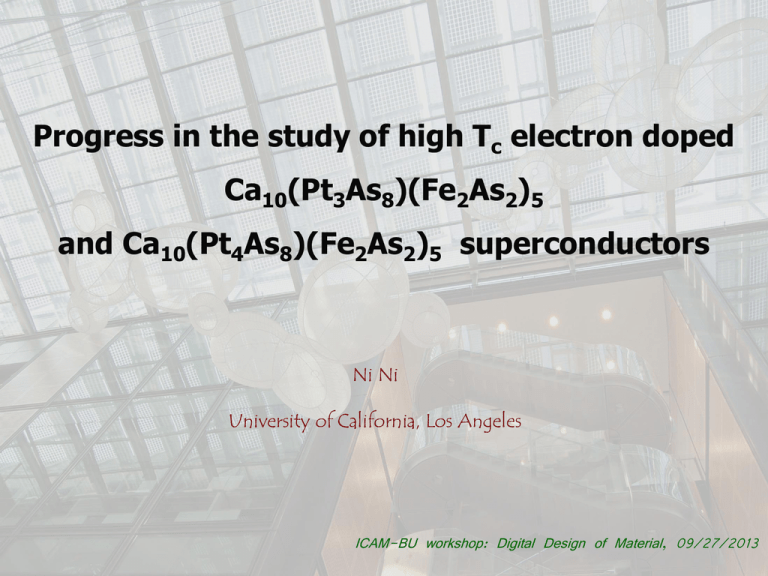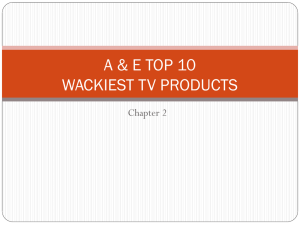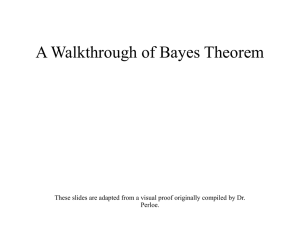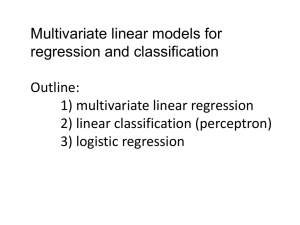PPT - Site BU
advertisement

Progress in the study of high Tc electron doped Ca10(Pt3As8)(Fe2As2)5 and Ca10(Pt4As8)(Fe2As2)5 superconductors Ni Ni University of California, Los Angeles ICAM-BU workshop: Digital Design of Material, 09/27/2013 Back to 2008: the first Fe-Based High Tc superconductor: LaFeAsO1-xFx FeAs layer made of the edge-sharing FeAs4 tetrahedral is the conducting layer key structural ingredient Reinvestigate known compounds with FeAs layer and search for new compounds with this layer Y. Kamihara, H. Hosono, et. al. JACS, 130, 3296 (2008) History after 2008: Fe based superconductor families compound identified SC discovered derivatives after 2008 RE3+O2-FeAs (RE: La-Ce) 2000 2008 AE2+Fe2As2(AE: Ba, Sr) 1980 2008 CaFe2As2 Li1+FeAs 1968 2008 NaFeAs KFe2As2 1981 2008 (Srn+1ScnO3n-1)(Fe2As2) 2009 ((Srn+1TMnO3n-1)(Cu2S2) know in 1999 ) Ca10(PtnAs8)(Fe2As2)5 (n=3,4) 2011 Fe1.01Se 1933 (new structure type) 2011 AE2+F1-FeAs (AE=Ca, Sr, Ba) AFe2As2 (A: Na, Rb, Cs) many Pd version 2008 Lix(NH2)y(NH3)1-y, intercalation KxFe2-ySe2 2010 (KCo2Se2 known in 1989) 2010 FeSe, LiFeAs, BaFe2As2, KFe2As2 were all identified well before the Cuprate were found superconducting, but pnictide’s superconductivity were uncovered recently. Maybe more high Tc superconductors are sleeping in our data base, waiting for theorists & experimentalists to wake up History after 2008: Fe based superconductor families compound identified SC discovered derivatives after 2008 RE3+O2-FeAs (RE: La-Ce) 2000 2008 AE2+Fe2As2(AE: Ba, Sr) 1980 2008 CaFe2As2 Li1+FeAs 1968 2008 NaFeAs KFe2As2 1981 2008 (Srn+1ScnO3n-1)(Fe2As2) 2009 ((Srn+1TMnO3n-1)(Cu2S2) know in 1999 ) Ca10(PtnAs8)(Fe2As2)5 (n=3,4) 2011 Fe1.01Se 1933 (new structure type) 2011 AE2+F1-FeAs (AE=Ca, Sr, Ba) AFe2As2 (A: Na, Rb, Cs) many Pd version 2008 Lix(NH2)y(NH3)1-y, intercalation KxFe2-ySe2 2010 (KCo2Se2 known in 1989) 2010 FeSe, LiFeAs, BaFe2As2, KFe2As2 were all identified well before the Cuprate were found superconducting, but pnictide’s superconductivity were uncovered recently. Maybe more high Tc superconductors are sleeping in our data base, waiting for theorists & experimentalists to wake up New superconductors in the Ca-Fe-Pt-As quaternaries Nohara group: Idea: superconductivity may occur in AEFe2As2 systems by creating deficiencies on Fe sites. Try Ca:(Fe+Pt):As ~1 : 2-x : 2 rather than 1 : 2 : 2 What they got are not what they hope for, but two brand new superconductors : One is a low temperature phase, Tc~13K; the other phase has Tc up to 38K New structure type with -Ca-(PtnAs8)-Ca-(Fe2As2)- stacking triclinic Ca10(Pt3As8)(Fe2As2)5 Ca10(Pt4-λAs8)(Fe2As2)5 tetragonal triclinic----Pt rich Three different phases crystalized in new structural types These structurally and chemically similar compounds make direct comparison plausible new insight in achieving high Tc? 1.5 (a) H=0T -3 1.0 Sizable single crystals -2 H = 0T T2 T1 -4 -6 Normal state: H = 9T 80 Tmin 100 120 0.5 Anomalies around 100 K (b) 2 H // ab H=4T 1.02 1.00 0.98 50 100 150 200 250 300 1 2 Cp/T (J/mole Fe2-K ) 100 50 -RH(cm /C) 0 x=0 0.1 0.01 0.02 Revealed by polarized-light optical imaging and Powder X-ray diffraction 0.01 0.00 0 5 10 15 20 25 2 2 T (K ) H ab |H| = 9T 1E-3 0 Two kinks in derivative of resistivity Related to structural/magnetic phase transitions Structural phase transition: 0.03 150 (c) 3 d/dT(10 m-cm/K) Cp (J/mole-K) (10-3emu/mole) (m-cm) The ground state of the parent 10-3-8 phase 50 100 150 200 250 300 T (K) Magnetic phase transition: Revealed by NMR and μSR Ni Ni, et. al., PRB rapid communications, 87, 060507 (2013) K. Cho, et al., PRB rapid, 85, 020504 (2012) T. Zhou, et al., J. Phys.: Condensed Matter 25 122201(2013) T. Sturzer, et al., J. Phys.: Condensed Matter 25 122203(2013) 10-3-8 phase: La substitution on Ca sites (b) R/R300 0.021 x=0 2 2 1 50% R/R300 0.043 10% 0 0 1 10 20 30 T (K) 0.065 SC occurs with La doping 0.093 0.145 and 0.182 0 0.6 (a) 100 200 T (K) Maximum Tc is 26 K in this study 300 15 (b) C /T =13 mJ/mole-Fe K2 p c 2 x=0.093 (Cp -Cp ) (mJ/mole-K ) 0 2 Tc=21.9 K T (K) 30 2 Cp/T (mJ/mol-K ) 2 Bulk SC 9T 20 0T Cp/T (J/mol- K ) 0 40 0 H=0T H=9T Highest Tc record in La doped 10-3-8 is 30 K 0 Tc 0.0 0 10 T (K) 20 10 20 T (K) 30 Ni Ni, et. al., PRB rapid communications, 87, 060507 (2013) 10-3-8 phase: Pt substitution on Fe sites 4 /(300K, 0T) 10-3-8 200 0 T (K) 3 x=0.004(2) 2 -3 Superconductivity can be induced by Pt substitution on Fe sites dR/dT(arb. unit) 0 The only superconductor known in a triclinic lattice 0.018(2) 0.028(3) 0.042(2) 1 0 The most anisotropic Fe based superconductor 0.097(2) 0 ' (emu/g) 0.00 100 T (K) 300 0.018(2) 0.028(3) H=0.5 mT H // ab 0.042(2) -0.02 0 200 0.097(2) 5 T (K) 10 15 Ni Ni, R.J.Cava et. al., PNAS, 108, E1019-E1026 (2011) K. Cho, R. Prozorov, PRB, 85, 020504 (2012) 10-4-8 phase: Pt substitution on Fe sites Normal state is a poor metal. Bulk SC is confirmed. Unlike the 10-3-8 phase, due to the difficulty in growing pure homogeneous samples, the relation between the chemical composition and the superconducting properties were not reported consistently in different groups. Ca10(Pt4-λAs8)((Fe1-xPtx)2As2)5 K. Kudo, M. Nohara et. al., JPSJ, 80 (2011) C. Lohnert, D. Johrendt, Angew. Chem. Int. Ed. 50, 9195 (2011) Tc=38K λ = 0, x=0.18 Triclinic structure Tc=35K λ = 0.42, x=0 Tetragonal structure obtained by Rietveld refinement of synchrotron power Xray diffraction pattern of well characterized pieces. obtained by Rietveld refinement of power X-ray diffraction pattern Q.P. Ding, T. Tamegai, et. Al., PRB, 85, 104512 (2012) Ni Ni, R.J.Cava, et. al., PNAS, 108, E1019-E1026 (2011) Tc=33K λ = 0.49, x=0.02 Tetragonal structure Tc=26K λ = 0.246, x=0.03 Tetragonal structure obtained by EDX measurement obtained by single crystal X-ray measurement and EDX From the reports from different groups, no unified trend of the relation of Tc and concentration can be extracted Investigation in this system is needed to reliably build up this λ, x and Tc phase diagram Comparison between these two phases Extra electron count? As-Fe-As bond angle? Not enough. One hypothesis: the nature of the spacer layer Chemical point of view: [Ca10 ]20+ (Pt3As8)10-[(Fe2As2)5]10is valence satisfied Zintl compound semiconducting nature of Pt3As8 layer weak interlayer FeAs coupling in 10-3-8 phase. Ni Ni, et. Al., PNAS, 108, E1019-E1026 (2011) Comparison between these two phases Structural point of view: One interlayer Pt-As interaction channel per unit cell in 10-3-8; two in 10-4-8 weaker interlayer coupling in 10-3-8 and better isolated Pt3As8 layers Pt3As8 layer is more electronically blocking and its semiconducting nature is reinforced weak interlayer FeAs coupling in 10-3-8 phase. The importance of the interlayer coupling and metallicity of the spacer layer Ni Ni, et. Al., PNAS, 108, E1019-E1026 (2011) Comparison between two phases The other hypothesis: 10-3-8 can be taken as the parent compound for 10-4-8. The reason 10-4-8 shows higher Tc is because the extra Pt indirectly doped the FeAs layer----- rigid band approximation Recently ARPES measurements have provided some clue. C. Lohnert, D. Johrendt, Angew. Chem. Int. Ed. 50, 9195 (2011) ARPES: electronic structures of 10-3-8 and 10-4-8 phase Sample: underdoped 10-3-8: Tc=8K M. Z. Hasan, et. al, Phys. Rev. B 85, 094510 (2012) optimal doped 10-3-8: Tc=15 K S. V. Borisenko, et. al., arxiv: 1307.1608v1 (2013) 1. One hole pockets at zone center, one electron pocket at zone corner 2. No Fermi pocket from Pt3As8 layer 1. Two hole pockets at zone center, one electron pocket at zone corner 2. No Fermi pocket from Pt3As8 layer, indicating they are weakly coupled to the FeAs layers ARPES: electronic structures of 10-3-8 and 10-4-8 phase Sample: underdoped 10-3-8: Tc=8K M. Z. Hasan, et. al, Phys. Rev. B 85, 094510 (2012) optimal doped 10-3-8: Tc=15 K S. V. Borisenko, et. al., arxiv: 1307.1608v1 (2013) 1. One hole pockets at zone center, one electron pocket at zone corner 2. No Fermi pocket from Pt3As8 layer 1. Two hole pockets at zone center, one electron pocket at zone corner 2. No Fermi pocket from Pt3As8 layer, indicating they are weakly coupled to the FeAs layers ARPES: electronic structures and Fermi surface Ca10(Pt4-λAs8)((Fe1-xPtx)2As2)5, near optimal 10-4-8: Tc=35 K; overdoped 10-4-8: Tc=22 K S. V. Borisenko, et. al., arxiv: 1307.1608v1 (2013) D. L. Feng, et. al, arxiv: 1308.3105v1 (2013) from Pt4As8 layer 1. No pocket observed from Pt4As8 layer 2. only one dxy-originated hole pocket around the zone corner, but the top of dxz and dyz band coincide and lie at the Ef 1. Electron pocket from Pt4As8 layer-----the first Fe based superconductor with a metallic spacer layer. 2. only one dxy-originated hole pocket in zone center 3. negligible kz dependence ARPES: electronic structures and Fermi surface Ca10(Pt4-λAs8)((Fe1-xPtx)2As2)5, near optimal 10-4-8: Tc=35 K; S. V. Borisenko, et. al., arxiv: 1307.1608v1 (2013) Not rigid band overdoped 10-4-8: Tc=22 K D. L. Feng, et. al, arxiv: 1308.3105v1 (2013) ARPES: electronic structures and Fermi surface Ca10(Pt4-λAs8)((Fe1-xPtx)2As2)5, near optimal 10-4-8: Tc=35 K; overdoped 10-4-8: Tc=22 K D. L. Feng, et. al, arxiv: 1308.3105v1 (2013) S. V. Borisenko, et. al., arxiv: 1307.1608v1 (2013) Not rigid band Ca10(Pt3As8)((Fe1-xPtx)2As2)5, optimal 10-3-8 underdoped 10-3-8 Field-induced spin-flop of AFM fluctuation in Pt doped 10-3-8 Watson, Coldea, et. al., to be submitted (2013) a clear anomaly in the magnetic torque data when H is perpendicular to ab plane. It is symmetric to the normal to the ab plane. This is unique in Fe pnictides. Spin-flop of antiferromagnetic fluctuation Summary of this review 1. Structural/magnetic phase transitions occur in 10-3-8 parent compound 2. Bulk SC up to 38 K has been induced in 10-3-8 and 10-4-8 3. Optimal doped 10-4-8 shows two band-edge singularities at Ef, possibly giving rise to higher Tc; overdoped 10-4-8 has an electron pocket at zone center coming from Pt4As8 layer, indicating the first Fe pnictide superconductor with a metallic spacer layer; rigid band approximation can not be assumed from 10-3-8 phase to optimal 10-4-8 phase to overdoped 10-4-8 phase. 4. Field induced spin-flop transition of AFM fluctuation is observed in nearly optimal doped 10-3-8. The effects of applied external pressure Superconductivity up to 10 K can be induced by applied pressures Ni Ni, et. Al., PNAS, 108, E1019-E1026 (2011) Peiwen Gao, Liling Sun, et. al., Arxiv: 1301.2863 (2013) The ground state of the parent 10-3-8 phase Structural phase transition exists : polarized-light optical imaging K. Cho, et al., PRB rapid, 85, 020504 (2012) X-ray diffraction T. Sturzer, et al., J. Phys.: Condensed Matter 25 122203(2013) The ground state of the parent 10-3-8 phase NMR shows long range AFM T. Zhou, et al., J. Phys.: Condensed Matter 25 122201(2013) μSR shows long range AFM T. Sturzer, et al., J. Phys.: Condensed Matter 25 122203(2013) CaFe2As2: Ts/TSDW=170K The insertion of the intermediary Pt3As8 layer leads to longer FeAs distance, which may lead to the lower structural and magnetic phase transitions.









